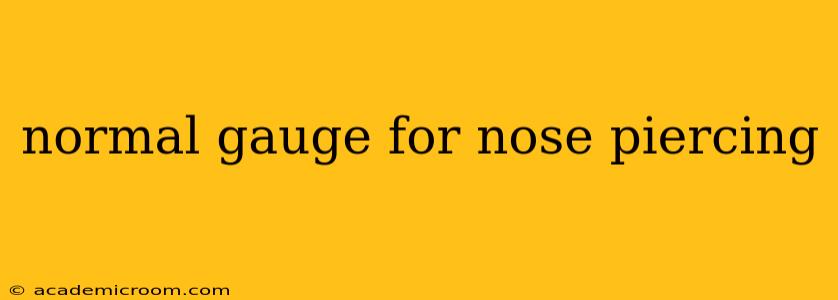Choosing the right gauge for your nose piercing is crucial for both the healing process and the overall aesthetic. This guide delves into the common gauges used for nose piercings, helping you make an informed decision. We’ll also address frequently asked questions to ensure you’re well-prepared for your piercing journey.
What is a Gauge?
Before we dive into specifics, let's clarify what "gauge" means in the context of piercings. Gauge refers to the thickness of the jewelry, expressed as a number. The smaller the number, the thicker the jewelry. This might seem counterintuitive at first, but it's a standard system used across the body piercing industry.
Common Gauges for Nose Piercings
The most common gauge for initial nose piercings is 20 gauge (0.8mm). This is a good starting point because it's thin enough to minimize trauma during the piercing process but thick enough to support the initial jewelry and withstand the healing period. Many piercers will recommend this size due to its ease of healing and lower risk of complications.
Some individuals might opt for a slightly thinner 22 gauge (0.7mm), particularly if they have thin nasal cartilage. However, it's important to note that this gauge is more delicate and may be prone to bending or damage, especially during the early stages of healing.
Larger gauges, such as 18 gauge (1.0mm) and above, are generally not recommended for initial piercings. They create larger holes, increasing the risk of complications and longer healing times. These gauges are often used for later jewelry changes after the piercing has fully healed.
What Gauge is Best for Me?
The best gauge for your nose piercing depends on several factors, including:
- Your Anatomy: The thickness and density of your nasal cartilage will influence the appropriate gauge.
- Your Piercer's Recommendation: A reputable piercer will assess your anatomy and advise you on the most suitable gauge. This is crucial for a safe and successful piercing.
- Your Personal Preference: While the initial piercing is usually done with a 20g or 22g needle, you can always choose to change the jewelry to a different gauge after complete healing.
It's always best to consult with an experienced professional piercer. They will be able to give you personalized advice based on your individual circumstances.
How Long Does a Nose Piercing Take to Heal?
The healing time for a nose piercing varies depending on several factors, including the gauge, aftercare, and individual healing rates. On average, a nose piercing takes 4-6 months to heal. However, it can take longer, sometimes up to a year, for the piercing to completely heal. During this time, proper aftercare is crucial to prevent infection and complications.
What Should I Do if My Piercing Gets Infected?
It's important to seek immediate professional medical advice if you suspect your nose piercing has become infected. Signs of infection can include redness, swelling, pus, pain, or excessive bleeding. Do not attempt to self-treat.
Can I Change My Nose Ring After Healing?
Yes, once your nose piercing is fully healed (typically 4-6 months, sometimes longer), you can usually change your jewelry. However, ensure you use sterile jewelry and techniques to minimize the risk of infection. If you're unsure, consult your piercer.
Conclusion
Choosing the right gauge for your nose piercing is a crucial step towards a safe and satisfying experience. Prioritize a reputable piercer, follow their advice regarding gauge, and diligently follow aftercare instructions to ensure a smooth healing process and beautiful result. Remember that a smaller gauge (higher number) is generally preferable for initial piercings, promoting faster healing and minimizing complications.
